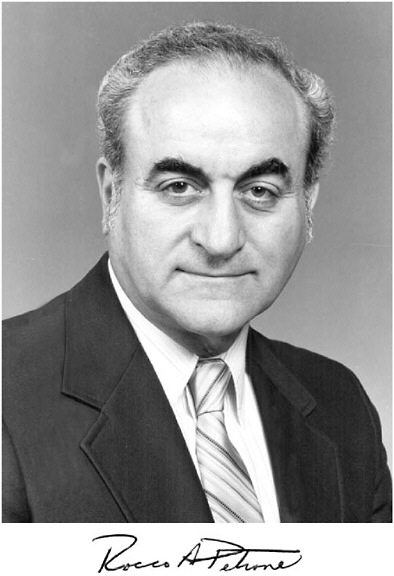ROCCO A. PETRONE
1926–2006
Elected in 1975
“For pioneering accomplishments in the design, development, and implementation of space launching capabilities for the Apollo program.”
BY WILLIAM R. LUCAS
ROCCO A. PETRONE, a pioneer in rocketry and space flight, died on August 24, 2006, at his home in Palos Verdes Estates, California. From humble beginnings, and with an uncommon intellect and unexcelled work ethic, he became one of the most important contributors to space technology of the 20th century. Among the many thousands of people who were involved in landing men on the moon and returning them safely to Earth, Rocco was one of a very small group of leaders whose contributions were critical to that effort. He was elected to the National Academy of Engineering in 1975.
Rocco was born on March 31, 1926, to Italian immigrant parents in Amsterdam, New York. In 1946, he graduated from the U.S. Military Academy, where, in addition to his academic leadership, he played tackle on the great Army football teams of the 1940s. After graduation, he served in the U.S. Army in Europe from 1947 to 1950. Upon his return to the United States, he studied at Massachusetts Institute of Technology (MIT) and earned a master’s degree in 1951 and a professional degree in 1952, both in mechanical engineering.
Rocco’s career in rocketry began in the early 1950s at Redstone Arsenal in Huntsville, Alabama, where, as an army officer, he joined the team headed by Wernher von Braun. He was assigned to the Missile Firing Laboratory, which was responsible for the development of hardware and techniques for the launch of bal-
listic missiles. In 1953, he participated in the launch of the Redstone missile, the first U.S. ballistic missile. He participated in subsequent launches of the Redstone missile, Jupiter missile, Pershing missile, and Jupiter C and Juno space launch vehicles.
In 1960, still on active duty in the U.S. Army, he was appointed manager of that part of the National Aeronautics and Space Administration (NASA) Saturn Program assigned to the Kennedy Space Center. When the Apollo Lunar Landing Program was established with the goal of landing men on the moon and returning them safely to Earth, Rocco was responsible for the planning, development, and activation of all launch facilities, including Launch Complex 39, where the Apollo/Saturn V vehicles were launched. The complex included the Vehicle Assembly Building, the launch towers, and the 3,000-ton Saturn V Crawler-Transporter, which transported the stacked Saturn V from the Assembly Building to the launch pad about three miles away.
In 1966, Rocco retired from the army and was employed immediately by NASA as director of launch operations, Kennedy Space Center, where he was responsible for the management and technical direction of pre-flight operations and systems integration, testing, checkout, and launch of all space vehicles. He personally directed the launches of the first five crewed Apollo vehicles, culminating with Apollo 11, which landed two crew members on the moon.
In 1969, Rocco was named Apollo program director, NASA Headquarters, Washington, D.C. He served in that capacity until 1973 when he was appointed director of the Marshall Space Flight Center (MSFC), where he presided over the participation of MSFC in the three Skylab missions, America’s first space station. He directed a remarkable recovery after the critical loss of the Skylab heat shield on its first mission. He also oversaw the downsizing of MSFC in preparation for MSFC’s changing roles in the late 1970s. In 1974, Rocco was appointed associate administrator of NASA and technical director of all of NASA’s aeronautical and space programs. He also had overall responsibility for the Apollo-Soyuz Test Program, a joint venture by the United States and the Soviet Union.
In 1975, Rocco retired from NASA and accepted a position as president and chief executive officer of the National Center for Resource Recovery, a joint industry/labor effort to develop technologies for recovering materials and energy from solid waste. He considered this a challenge of national importance.
In 1981, he was appointed president of the Space Transportation Systems Group of Rockwell International Corporation, where he was responsible for the production of hardware for the Space Shuttle Orbiter and other space hardware. In 1987, he was appointed vice president of corporate development, Rockwell International, and he retired from that position in 1989. During his retirement, he pursued his hobbies, including civil war history and attending sporting events, with characteristic vigor.
Throughout his long professional career, Rocco demonstrated impeccable integrity. He was a shining example of the motto he had learned at the military academy, “Duty, Honor, Country.” Rarely does one encounter a more committed or effective manager than Rocco Petrone. He always focused on the objective, was well informed of technical details, and was rigidly disciplined. Some called him a tough manager because he required the same discipline from those who reported to him as he demonstrated himself.
Rocco Petrone left a legacy of excellence in the art and science of managing massive technical programs involving people from different cultures with a wide range of talents and skills. Guided by extraordinary engineering insight, he had an uncanny ability to ask the right questions when assessing the integrity of a design or the readiness of hardware for flight. He also had the courage to do what seemed right, often under great stress. The successful launches of all of the Saturn V rockets are testimony to his excellence.
Rocco is survived by his wife of more than 50 years, Ruth Holley Petrone, and four adult children, Michael Petrone, Kathy Petrone Posey, Terry Petrone, and Nancy Petrone.





